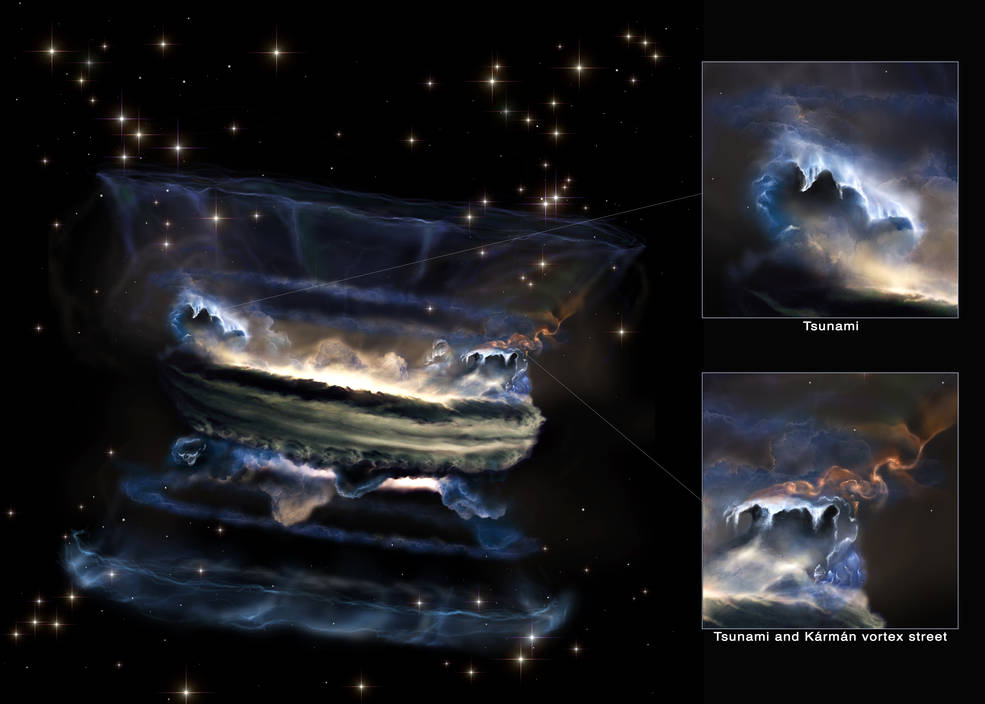Supermassive black holes could host giant, swirling gas 'tsunamis'
Could gas escaping the gravitational grasp of supermassive black holes be forming "tsunamis" in space?
In a new, NASA-funded study, astrophysicists used computer simulations to model the environment around supermassive black holes in deep space. They found that there could be massive, tsunami-like structures forming near these black holes that are essentially massive, swirling walls of gas that have narrowly escaped the intense gravitational pull of the black hole. They even think that supermassive black holes could host the largest tsunami-like structures in the universe.
"What governs phenomena here on Earth are the laws of physics that can explain things in outer space and even very far outside the black hole," Daniel Proga, an astrophysicist at the University of Las Vegas, Nevada (UNLV), said in a NASA statement.
Gallery: Black Holes of the Universe
In this study, researchers took a close look at the strange environment around supermassive black holes and how gases and radiation interact there.
Supermassive black holes sometimes have large disks of gas and matter that swirl around them, feeding them over time in a combined system known as an active galactic nucleus. These systems, which often shoot out jets of material, emit bright, shining X-rays above the disk, just out of gravitational reach of the black hole. This X-ray radiation pushes winds that stream out of the center of the system. This is called an "outflow."
This X-ray radiation could also help to explain denser, gaseous regions in the environment around supermassive black holes called "clouds," the researchers think.
Breaking space news, the latest updates on rocket launches, skywatching events and more!
"These clouds are 10 times hotter than the surface of the sun and moving at the speed of the solar wind, so they are rather exotic objects that you would not want an airplane to fly through," lead author Tim Waters, a postdoctoral researcher at UNLV who is also a guest scientist at Los Alamos National Laboratory in New Mexico, said in the same statement.
The team showed with computer simulations how, far enough away from the black hole to be outside of its reach, the atmosphere of the disk spinning around the black hole can start to form waves of gas and matter. With the addition of the outflow winds that are pushed out by X-ray radiation, these waves can grow into massive tsunamis. These swirling waves of gas can stretch up to 10 light-years above the disk, the researchers found. Once these tsunami-like structures form, they are no longer under the influence of the black hole's gravity, according to the statement.
In these simulations, the researchers showed how bright X-ray radiation close to a black hole seeps into pockets of hot gas in the outer atmosphere of the disk. These bubbles of hot plasma expand into nearby, cooler gas at the edges of the disk, helping to spur the tsunami-like structures. The bubbles also block the outflow wind and spiral off into separate structures up to a light-year in size. These side structures are known as Kármán vortex streets, which are weather patterns that also occur on Earth (though on Earth, this pattern of swirling vortexes looks quite different.)
Kármán vortex streets are named for the Hungarian-American physicist Theodore von Kármán, whose name also marks the boundary between Earth's atmosphere and space.
This research goes against previous theories that have suggested that clouds of hot gas near an active galactic nucleus form spontaneously because of fluid instability, according to the statement. This study also contradicts the previous notion that magnetic fields are necessary to move cooler gas from a disk around a supermassive black hole.
While no satellites currently operational can confirm their work, the team hopes to bolster their findings with future research and hopefully telescopic observations. Additionally, observations of plasma near active galactic nuclei from NASA's Chandra X-ray Observatory and the European Space Agency's XMM-Newton space telescope are consistent with this team's findings, according to the statement from NASA.
This work was published June 15 in the Astrophysical Journal.
Email Chelsea Gohd at cgohd@space.com or follow her on Twitter @chelsea_gohd. Follow us on Twitter @Spacedotcom and on Facebook.

Chelsea “Foxanne” Gohd joined Space.com in 2018 and is now a Senior Writer, writing about everything from climate change to planetary science and human spaceflight in both articles and on-camera in videos. With a degree in Public Health and biological sciences, Chelsea has written and worked for institutions including the American Museum of Natural History, Scientific American, Discover Magazine Blog, Astronomy Magazine and Live Science. When not writing, editing or filming something space-y, Chelsea "Foxanne" Gohd is writing music and performing as Foxanne, even launching a song to space in 2021 with Inspiration4. You can follow her on Twitter @chelsea_gohd and @foxannemusic.


